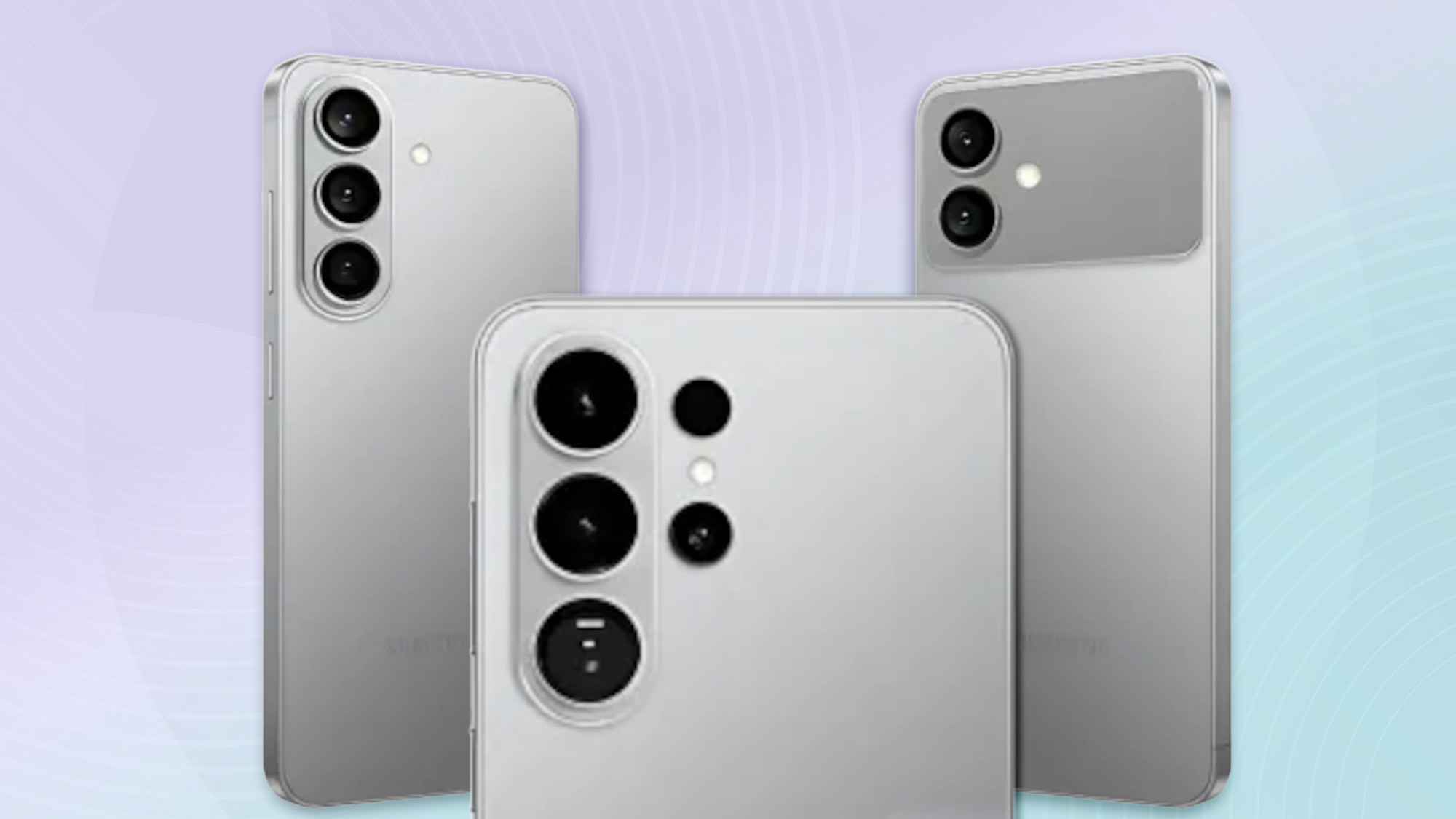Tom's Guide Verdict
Gamers will like the powerful processor and 144Hz refresh rate on the Motorola Edge Plus (2022). But the lack of a telephoto lens makes this a hard sell over the Galaxy S22 or iPhone 13 Pro.
Pros
- +
Powerful Snapdragon 8 Gen 1 chipset
- +
Big, colorful screen
- +
Main camera produces solid pictures
- +
144Hz refresh rate
Cons
- -
No telephoto lens
- -
Plastic design
- -
Subpar battery life
Why you can trust Tom's Guide
The Motorola Edge Plus (2022) is a follow-up to the 2020 phone of the same name that marked Motorola's return to the flagship phone market. The older Edge Plus was a fine phone in many ways that failed to distinguish itself from the high-end options it was looking to upend. In contrast, Motorola's new model does stand out, but not always for reasons the phone maker would prefer.
Display: 6.7 inches (2400 x 1080)
Refresh rate: 144Hz adaptive
CPU: Snapdragon 8 Gen 1
RAM: 8GB, 12GB
Storage: 128GB, 256GB
Rear cameras: 50MP (f/1.8) main; 50MP (f/2.2) ultrawide; 2MP (f/2.4) depth
Front camera: 60MP (f/2.2)
Battery: 4,800 mAh
Battery life (Hrs:Mins): 6:57 (144Hz), 8:24 (60Hz)
Charging speed: 30W wired; 15W wireless
Size: 6.4 x 3.0 x 0.35 inches
Weight: 6.9 ounces
While the Motorola Edge Plus (2022) ticks many of the boxes for features you'd expect from a best phone contender — top-of-the-line processor, a colorful display, peppy charging — it's what's missing that threatens to define this phone. Most premium flagships offer a telephoto lens among their rear camera offerings, for example — most phones except for the Motorola Edge Plus, that is.
Do these sins of omission diminish from the things Motorola gets right? Our Motorola Edge Plus review finds a solid phone that some Android fans are bound to find frustrating for a couple different reasons.
Motorola Edge Plus (2022) review: Price and availability
The Motorola Edge Plus (2022) has been on sale since late March, and it's available unlocked from Best Buy, Amazon, Walmart and Motorola.com. Normally priced at $999, the phone debuted with a $100 discount; you can still find that $899 price at several retailers. That $899 price places the Motorola Edge Plus (with 8GB of RAM and 512GB of storage) squarely between the $799 Galaxy S22 and $999 Galaxy S22 Plus from Samsung.
Verizon is also offering its own version of the Motorola Edge Plus, which is tailored to work with the carrier's 5G Ultra Wideband network — in fact, we tested the Verizon model of Motorola's new flagship for this Motorola Edge Plus (2022) review. The 8GB/128GB phone costs $849 at Verizon, and you can buy it in installments for 36 monthly payments of $23.61. The 12GB/256GB version costs $929.
Verizon offers up to $800 off on the phone with a qualifying trade-in; you'll also need to open a new line on a Verizon unlimited data plan to take advantage of that launch offer.
Motorola Edge Plus (2022) review: Design
For a phone that commands a premium price, the Motorola Edge Plus (2022) sure doesn't exude a high-end design. Motorola uses polycarbonate, which gives the Edge Plus a cheap feel. The contrast is even more dramatic if you happen to place the phone next to a Galaxy S22 or iPhone 13 model. Yes, you get Gorilla Glass on the front and back of the phone to guard against damage, but the Edge Plus lacks a premium feel.
Get instant access to breaking news, the hottest reviews, great deals and helpful tips.

You're also going to want to keep the Motorola Edge Plus away from water. The phone's IP52 water-resistance rating means it can stand up to a splash, but forget about protection from accidental dunks. IP67 and IP68 are generally the standard water-resistance ratings for phones in this price range, so Motorola's thinking here is a mystery.
I do like the Cosmos Blue hue of my review unit. (The phone also comes in Stardust White.) It gives the Motorola Edge a nice, glossy look while not picking up too many fingerprints. I also enjoy the front-firing speakers on the Motorola Edge Plus. They're good and loud without creating distortion as you pump up the volume. They're also placed in such a way as to not muffle the sound while holding the phone in landscape mode.
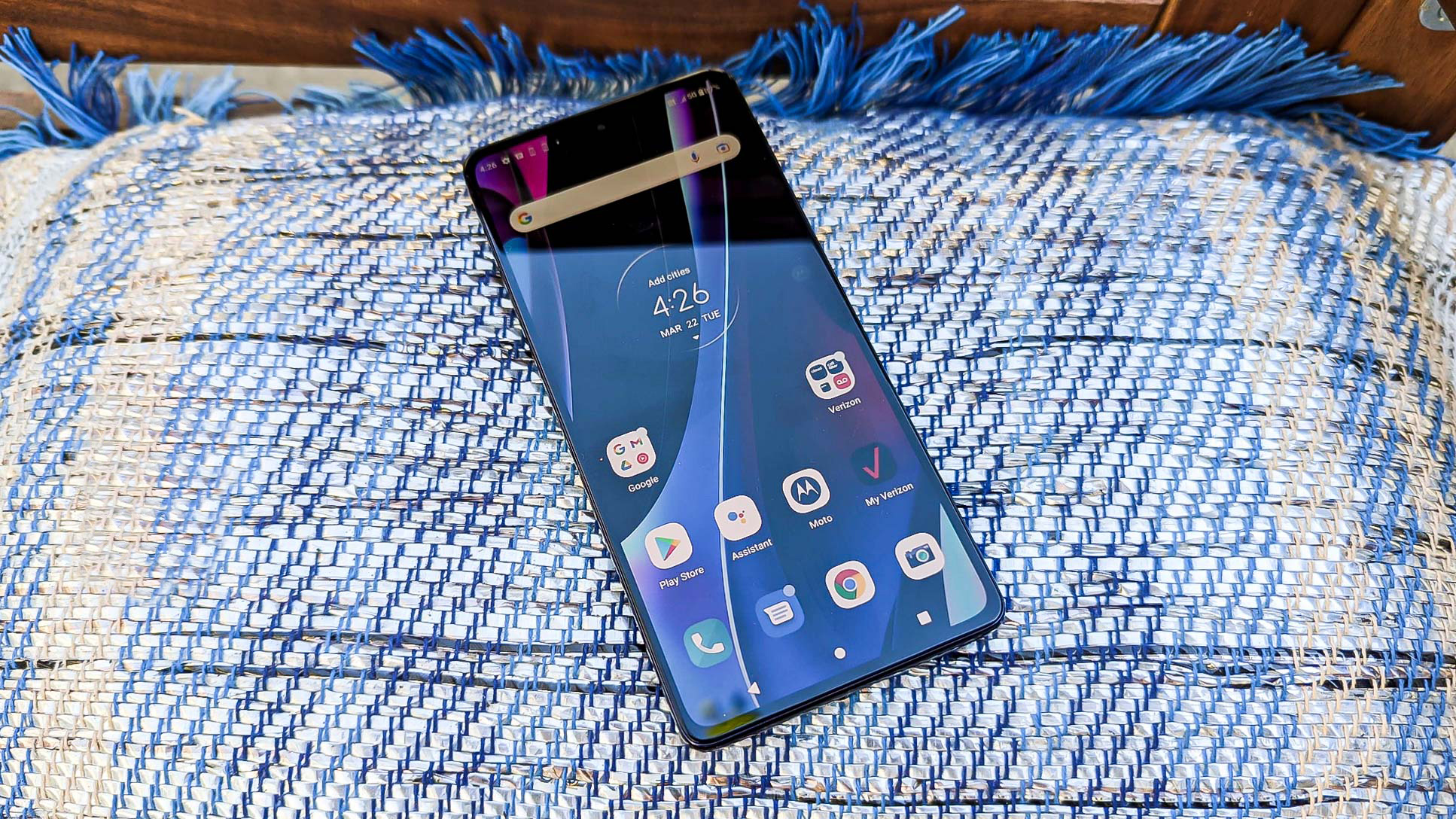
But other design decisions by Motorola are simply bizarre. The vertically stacked rear camera array is flush against the back of the phone on its sides, but raised at the top and bottom. This makes the phone wobble when you set the Motorola Edge Plus on its back. Motorola also placed the volume and power buttons too close together on the right side of the phone — I've lost count of how many times I've put the Edge Plus to sleep when I was just trying to adjust volume.
Motorola Edge Plus (2022) review: Display
Include Motorola in the group of phone makers that have made improving the displays on their flagship phones a top priority. In the case of the Motorola Edge Plus, that's meant focusing on the brightness and contrast of the 6.7-inch OLED display.
On the brightness front, it's a mixed bag for the Motorola Edge Plus (2022). With adaptive brightness turned on, we measured 629 nits of brightness with a light meter. That's dimmer than the 1,024-nit reading we got from the iPhone 13 Pro, not to mention the Pixel 6 Pro (824 nits). The Galaxy S22 Plus only hit 648 nits with adaptive brightness on, but when we enabled HDR, that improved to 1,132 nits, thanks to Samsung's efforts to boost the peak brightness of its phones' displays.
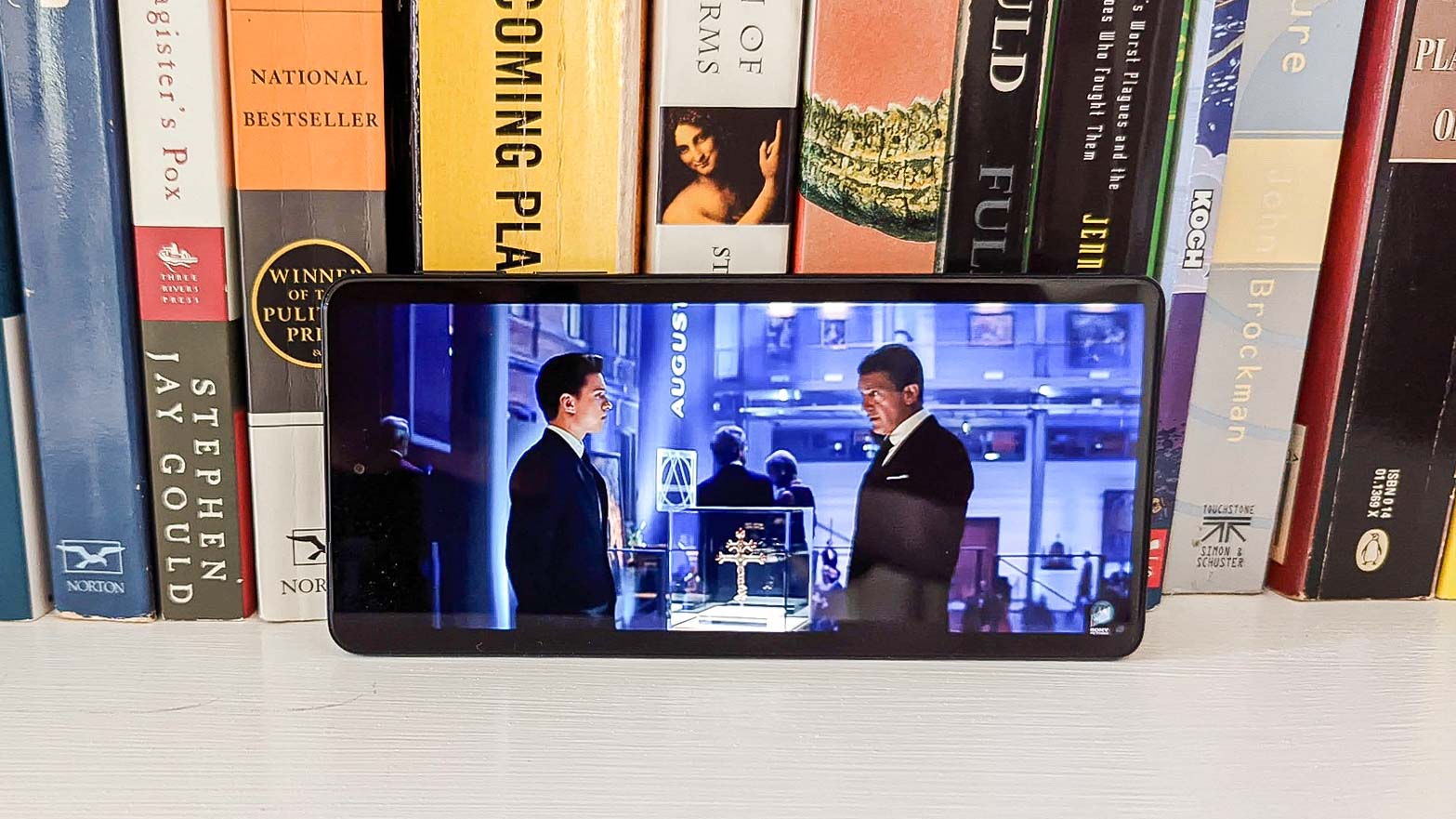
So the Motorola Edge Plus (2022) is not as bright as the competition. Yet, even with the display locked in at 80% brightness, I was able to see the display, though it did take some squinting in bright sunlight.
Colors on the Motorola Edge Plus' display really pop when in the default saturated mode, where we recorded the phone as capturing 192.1% of the sRGB color spectrum. That's not quite up to the 212.1% the Galaxy S22 Plus reaches in Vivid mode, but it's close. I found the shimmery dresses worn by the cast of Girls5Eva during a season finale concert were a bit brighter on the Motorola Edge Plus when in Saturated mode, and gaming was equally vibrant, though blues can look a little unnatural at times.
Switching to natural mode changes the sRGB reading on the Motorola Edge Plus (2022) to 104%. (The Galaxy S22 Plus hits 128.3% when it's set to Natural.) Colors also get more accurate, with the Delta-E rating for Motorola's phone shifting from 0.33 to 0.28 after the switch from Saturated to Natural. (Numbers closer to zero are better.) The Galaxy S22 Plus has the more accurate colors, though, based on its 0.23 Delta-E score in Natural mode.
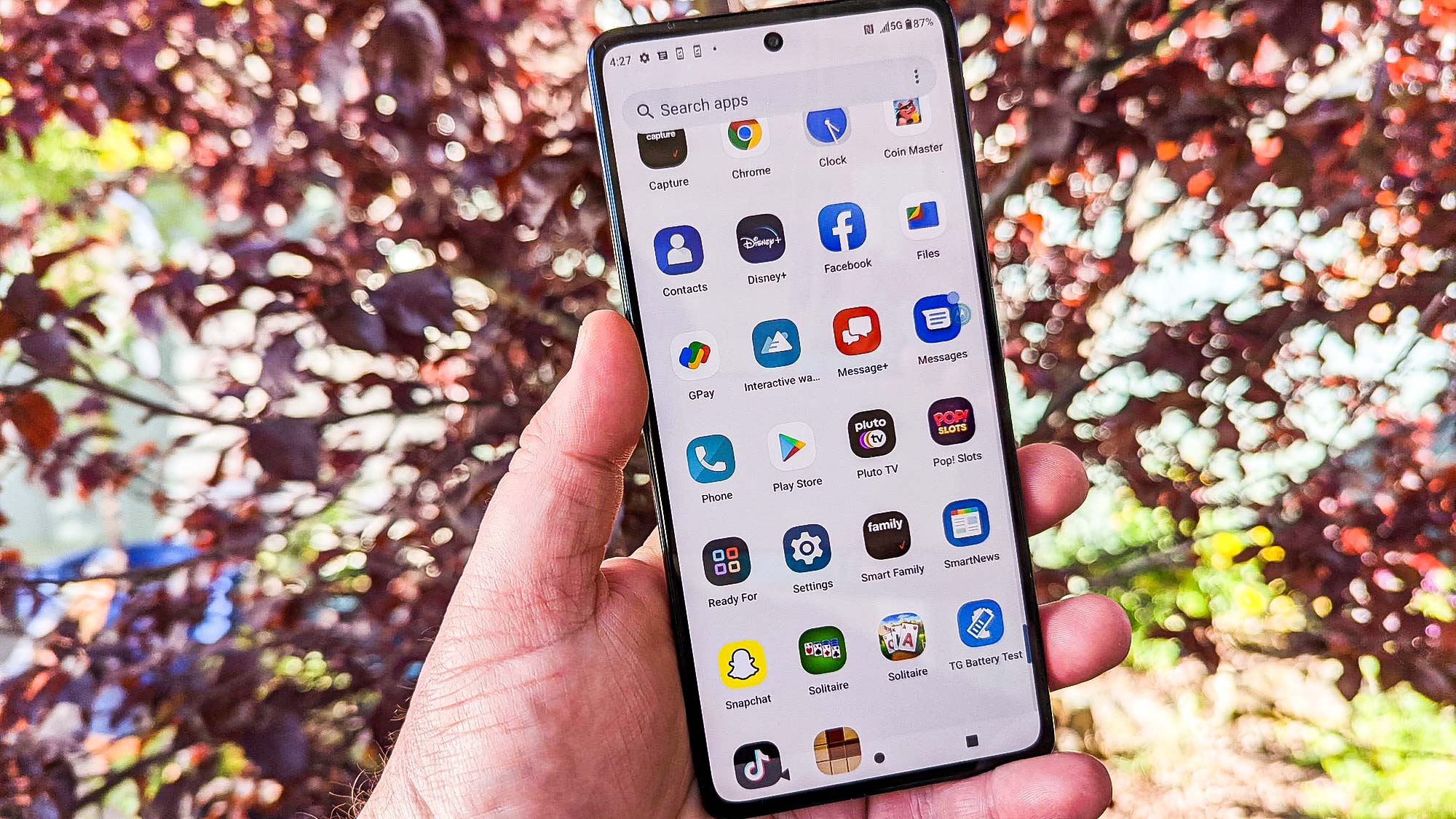
The Motorola Edge Plus (2022) boasts one other display feature, and it's a doozy — the screen refreshes at a 144Hz rate. Most fast-refreshing screens like the ones on the Galaxy S22 family top out at 120Hz. Usually, 144Hz is reserved for the best gaming phones, so that gives Motorola an edge over similar flagships. Even better, the rate adjusts based on your onscreen activity, though the higher refresh rate can drain the battery, as we'll discover below.
Motorola Edge Plus (2022) review: Cameras
The Motorola Edge Plus packs some serious optics, with a 50MP main sensor that promises all-pixel focus for sharper pictures. The ultrawide angle camera is a 50MP shooter, too, and it doubles as a macro lens for zooming in for greater detail. A 2MP depth sensor rounds out the rear cameras, while a 60MP front shooter is there for your selfie needs.
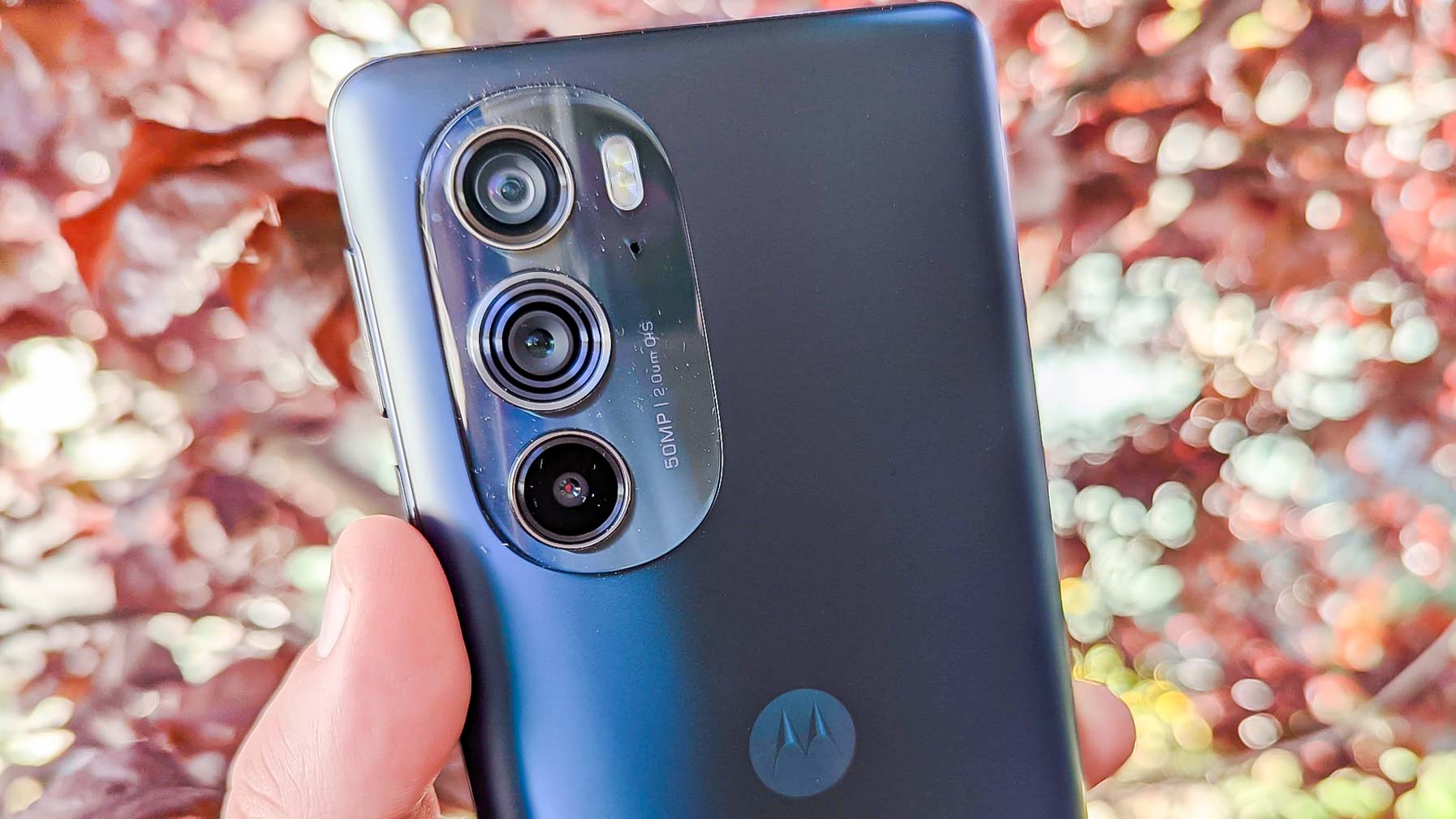
Given those features, it seems churlish to dwell on what isn't there, but it's hard to ignore the fact that Motorola expects you to pay anywhere from $849 to $999 for a phone that lacks a telephoto lens. Nearly every phone in that price range — the iPhone 13 Pro, the Galaxy S22 Plus, the Pixel 6 Pro — offers a dedicated telephoto lens with an optical zoom. On the Motorola Edge Plus, you're left at the mercy of a digital zoom.
It's a shame Motorola is ceding that ground to the best camera phones, because in many instances the Edge Plus competes quite well against rival devices. I much prefer the Edge Plus' photo at this fruit stand to what the Galaxy S22 produced.
Samsung's phones struggled with the sunlight, washing out the Fuji apples in the foreground and making the oranges next to them look like giant lemons. The Edge Plus was able to deal with that light while still keeping the different fruits' colors intact.
Motorola's emphasis on amping up colors was on display when I photographed this plate of tacos. Look at that carrot in both shots — it's a bright orange in the Edge Plus photo, but duller in the Galaxy S22's shot. The same could be said of the varying meats in the tacos, with the carne asada and carnitas looking particularly muted in the S22 shot.
Outside, the Galaxy S22 bathed my local movie theater in a darker shade, while the Motorola Edge Plus (2022) produced a much brighter shot. The shadows in the S22 photo swallow up some of the details — particularly the carved art deco flowers on the theater facade, which are more visible when viewed through the Edge Plus' main lens.
I took that theater shot in part to see what would happen when I zoomed in. There's not much distortion at 2x, though I suspect if I were to keep zooming, the Motorola Edge Plus photo would incorporate more noise while the S22 with its 3x optical zoom and support for 30x Super Resolution Zoom would keep things sharper. This particular photo's all right from Motorola's camera phone, but not so much that it excuses the absence of a telephoto lens on a premium phone.
The 50MP main camera on the Motorola Edge Plus, which has captured all of these shots up until now, is holding up its end of the bargain. It's when we move away from the main camera or turn to some of the software-powered features on board Motorola's phone that photo quality begins to flag.
The main differences in these shots of a church captured with the ultrawide angle lenses of each phone is that the Motorola Edge Plus image features colors that aren't as bold as what the S22 produced. The Galaxy S22 uses a deeper blue for the sky, and the tree on the left side of the shot is a little bit greener — I think it's a better look overall.
Because of how we have to crop these photos to turn them into comparison shots, you can't see the full view, but the Galaxy S22 captures slightly more detail thanks to a wider field of view — 120 degrees to 114 degrees for the Edge Plus. Both phones have a pronounced bend to the edges of their photos.
Because Motorola touts the macro camera capabilities of the Edge Plus, I tried taking a shot using the phone's dedicated macro mode. I can't claim to be impressed with the results on this close-up of a flower, largely because of the shadow over the shot by me. It's worth noting the TCL 30 V didn't have that problem when I took the same photo with that device's dedicated macro sensor, and the TCL phone costs between $500 to $600 less than the Motorola Edge Plus (2022).
The Night Vision mode on the Motorola Edge Plus simply isn't up to the task of capturing a stuffed Kermit the Frog doll climbing in my apple tree at night. It manages to capture the image with minimal help from some ambient lighting. But it does so in such a way that the details of the shot are lost by the pumped-up artificial light. The Galaxy S22's Night shot still captures the red of the camellia plant growing next to the apple tree; the tone of the S22 shot is also more even throughout.
I asked a lot of both cameras when testing portrait mode on my daughter, as the sunlight was breaking through the orange tree behind her and casting tough-to-film shadows on her face. But again, it was too much to ask of the Motorola Edge Plus, which blew out the right side of her nose, while making her left eye look especially glassy.
The dedicated depth sensor helps with the background blur, though the Galaxy S22's superior AI did a better job recognizing what was hair and what wasn't. You'll also notice that the S22 did a better job contending with the shadows.
Moving to the front of the phones, more megapixels certainly matter, at least for these dueling selfies. While the S22 produces a more balanced shot — there's no pocket of sunlight over my shoulder as there is in the Motorola photo — the extra megapixels on the Edge Plus capture more detail. Plus, Motorola doesn't engage in the over-aggressive skin smoothing that Samsung likes to indulge in.
The Motorola Edge Plus (2022) cameras are pretty capable, but at this price, capable doesn't quite cut it. You can find more powerful cameras on phones that cost the same as the Edge Plus. And while Motorola throws in some nice video features — you can record 8K video at 24 frames per second and there's support for HDR10+ video capture — the overall package doesn't reach the standard set by premium phones.
Motorola Edge Plus (2022) review: Performance
The Motorola Edge Plus (2022) comes equipped with the Snapdragon 8 Gen 1, the same top-of-the-line chipset used to power the Galaxy S22 lineup. As a result, you'll get performance that matches any Android phone. Motorola also doesn't skimp on RAM, packing 12GB of memory into our review unit, so switching between apps is pretty smooth.
Motorola's choice of silicon is reflected in our benchmark results for the Edge Plus. The phone posted single- and multicore results of 1,196 and 3,644, respectively. That's slightly behind the Galaxy S22 Plus' single-core score of 1,214, but ahead of the 3,361 multicore result. It's also better than what you'll see from Android phones powered by last year's Snapdragon 888 chipset.

On the graphics front, the Motorola Edge Plus (2022) once again measures up well against other premium Android devices, producing 60.9 frames per second in 3DMark's Wild Life Unlimited benchmark. The Galaxy S22 Plus hit 60.1 fps in that same test.
Of course, the elephant in the room here is the iPhone 13 lineup, powered by Apple's A15 silicon, which handily outperforms the Snapdragon 8 Gen 1 found in phones like the Motorola Edge Plus (2022). The iPhone 13 Pro's scores in Geekbench 5 (1,733 in single-core, 4,718 in multicore) and Wild Life Unlimited (70 frames per second) are well ahead of anything Motorola's phone can muster. But you can say that of many of the best Android phones at this point.
In our real-world testing, we use Adobe Premier Rush to transcode 4K video and time the results. The Motorola Edge Plus' time of 43 seconds topped the 48-second result by the Galaxy S22 Plus, but the iPhone 13 Pro lapped both phones with a 26-second time.
Though it may not match the iPhone 13 in terms of raw power, there's little you can throw at the Motorola Edge Plus (2022) that's going to cause this phone to balk. I was able to jump between multiple apps with ease, and demanding games like PUBG Mobile played smoothly on Motorola's phone. In fact, given the processing power and 144Hz refresh rate, I can imagine mobile gamers flocking to the Motorola Edge Plus.
Motorola Edge Plus (2022) review: Battery life and charging
The Motorola Edge Plus may have a 4,800 mAh battery that promises two days of normal usage, but our testing found a device that comes up well short of that. With the screen's refresh rate set at 144Hz, the Motorola Edge fell 3 minutes shy of the 7-hour mark on our battery test, in which we have a phone continuously surf the web over cellular until it runs out of juice. That's 3 hours less than the average phone.
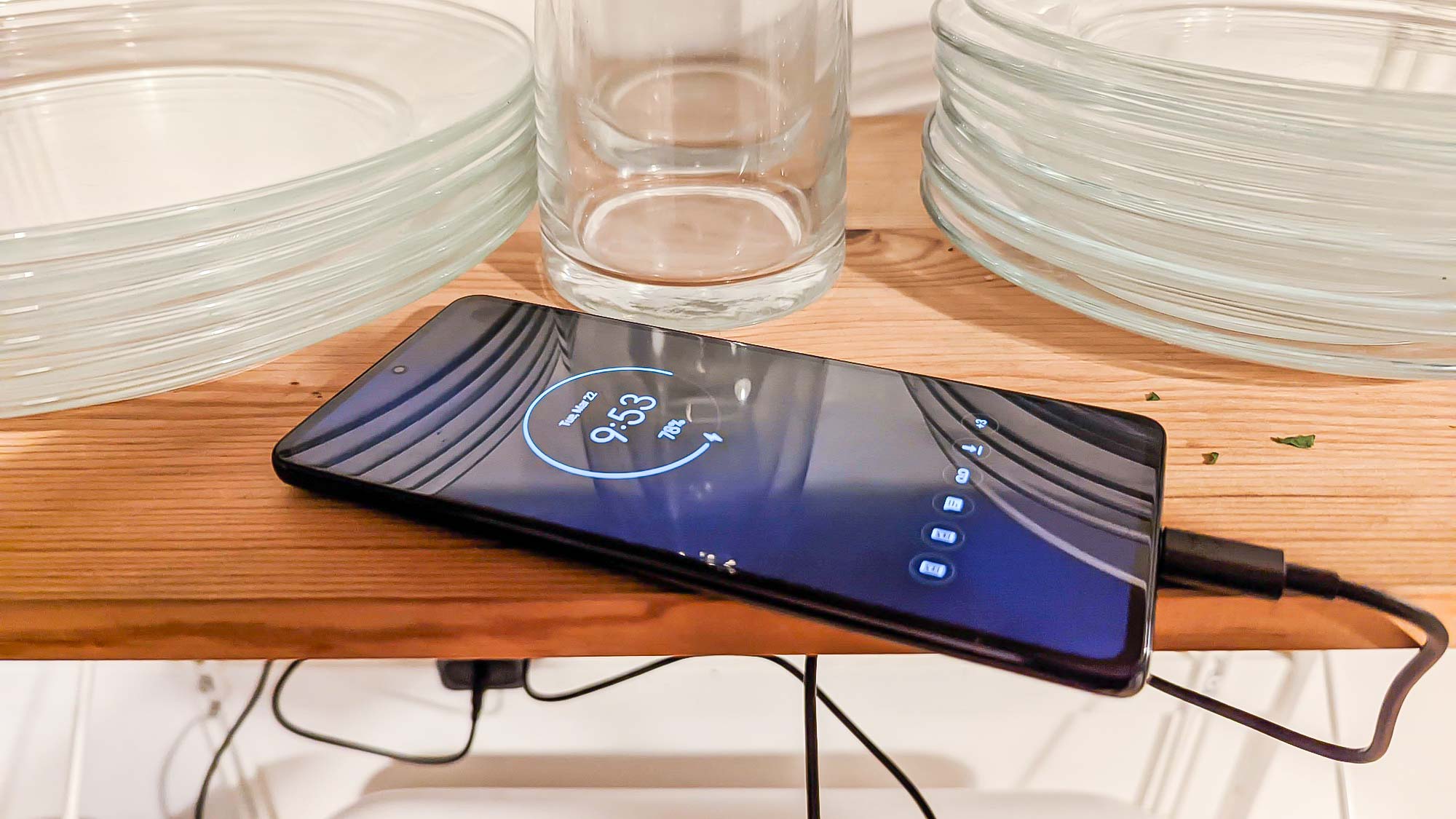
Our battery test is pretty demanding, but even in everyday use, I noticed the battery percentage ticking down when I used the Motorola Edge Plus. Several hours spent playing games and streaming video — again with the screen refresh rate maxed out at 144Hz — caused the battery indicator to dip by 30%.
Fast refresh rates can put a serious hurting on battery life, so I tested the phone again with the setting locked at 60Hz. The Motorola Edge Plus lasted longer this time, but its 8 hour and 24 minute time is still nothing to write home about. I plan to run additional testing, with the variable refresh rate enabled, but I suspect the time will skew closer toward the disappointing result I got when the phone's display had a steady 144Hz refresh rate.
At least the Motorola Edge Plus charges quickly, thanks to its support of 30W wired charging. That got a drained Edge Plus up to 63% after a half-hour with the charger that ships with the phone. The Galaxy S22, which charges at 25W was a little short of that at 60%.
Motorola Edge Plus (2022) review: Software and special features
One of the most intriguing additions to the Motorola Edge Plus (2022) is now available — an optional stylus and an accompanying folio case for $80. The stylus can connect to the Motorola Edge Plus (2022) over Bluetooth, giving it remote control capabilities, in addition to the standard uses of scribbling notes and doodles.
Does this sound reminiscent of the S Pen that's now included with the Galaxy S22 Ultra? Certainly, with the exception that Samsung's phone starts at $1,199, making the Motorola Edge Plus a relatively lower-cost alternative to that phablet. We hope to get our hands on the stylus now that it's available so we can see if that raises the Motorola Edge Plus in our estimation.

The features that are present at launch are certainly welcome. The Motorola Edge Plus (2022) ships with Android 12 with Motorola's stellar My UX skin built on top of it. Motorola takes few liberties with the Android experience, mostly adding helpful gesture-based shortcuts. The Edge Plus also supports Motorola's clumsily named Ready For feature, allowing you to connect the phone to an external display using it in desktop mode with your Windows 10 or Windows 11 machine.
If there's a disappointment on the software front, it's Motorola's software support, which remains wanting. The phone maker says to expect three years of security updates and at least two major Android upgrades. While more generous than in the past, it's short of Samsung's support, especially with that company now offering four years of software updates when you buy one of its flagships.
Motorola Edge Plus (2022) review: Verdict
Reviewing a phone means evaluating what's there, but sometimes what's not is too hard to overlook. And I'm trying really hard to justify how a phone that still costs $899 after a launch-period discount goes without a telephoto lens — a feature that other phones in this price range offer. The cheap-feeling design of the Motorola Edge Plus (2021) is another puzzler.
These decisions stand out even more because of the features that Motorola gets right. The main camera on the Edge Plus produces some pretty good shots. The phone can match any top Android device when it comes to performance, and the bright and colorful 6.7-inch display is a pleasure to look at. Gamers, in particular, might find plenty to like about the Motorola Edge Plus, thanks to that 144Hz refresh rate (provided they don't mind keeping a phone charger close at hand).
In the end, the Motorola Edge Plus (2022) finds itself in the in-between land for smartphones — not quite enough features to go up against the very best flagships, too big a price tag to be considered a midrange alternative. If Motorola really wants to compete in the flagship space, it needs to come up with phones that meet what people expect of a premium device, because right now, it's still falling short.
Philip Michaels is a Managing Editor at Tom's Guide. He's been covering personal technology since 1999 and was in the building when Steve Jobs showed off the iPhone for the first time. He's been evaluating smartphones since that first iPhone debuted in 2007, and he's been following phone carriers and smartphone plans since 2015. He has strong opinions about Apple, the Oakland Athletics, old movies and proper butchery techniques. Follow him at @PhilipMichaels.


